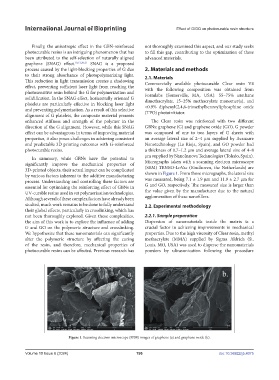Page 204 - IJB-10-6
P. 204
International Journal of Bioprinting Effect of G/GO on photocurable resin structure
Finally, the anisotropic effect in the GBN-reinforced not thoroughly examined this aspect, and our study seeks
photocurable resins is an intriguing phenomenon that has to fill this gap, contributing to the optimization of these
been attributed to the self-selection of naturally aligned advanced materials.
graphene (SNAG) effect. 10,12,20,21 SNAG is a proposed
process caused by the light-blocking properties of G due 2. Materials and methods
to their strong absorbance of photopolymerizing light. 2.1. Materials
This reduction in light transmission creates a shadowing Commercially available photocurable Clear resin V4
effect, preventing sufficient laser light from reaching the with the following composition was obtained from
photosensitive resin behind the G for polymerization and Formlabs (Somerville, MA, USA): 55–75% urethane
solidification. In the SNAG effect, horizontally oriented G dimethacrylate, 15–25% methacrylate monomer(s), and
platelets are particularly effective in blocking laser light <0.9% diphenyl(2,4,6-trimethylbenzoyl)phosphine oxide
and preventing polymerization. As a result of this selective
alignment of G platelets, the composite material presents (TPO) photoinitiator.
enhanced stiffness and strength of the polymer in the The Clear resin was reinforced with two different
direction of the G alignment. However, while this SNAG GBNs: graphene (G) and graphene oxide (GO). G powder
effect can be advantageous in terms of improving material was composed of one to two layers of G sheets with
properties, it also poses challenges in achieving consistent an average lateral size of 2–4 µm supplied by Avanzare
and predictable 3D printing outcomes with G-reinforced Nanotechnology (La Rioja, Spain), and GO powder had
photocurable resins. a thickness of 0.7–1.2 µm and average lateral size of 4–8
In summary, while GBNs have the potential to µm supplied by NanoInnova Technologies (Toledo, Spain).
significantly improve the mechanical properties of Micrographs taken with a scanning electron microscope
3D-printed objects, their actual impact can be complicated (SEM) TENEO-LoVac (Eindhoven, the Netherlands) are
by various factors inherent to the additive manufacturing shown in Figure 1. From those micrographs, the lateral size
process. Understanding and controlling these factors are was measured, being 7.1 ± 1.9 µm and 11.9 ± 2.7 µm for
essential for optimizing the reinforcing effect of GBNs in G and GO, respectively. The measured size is larger than
UV-curable resins used in vat polymerization technologies. the value given by the manufacturer due to the natural
Although several of these complex factors have already been agglomeration of these nanofillers.
studied, much work remains to be done to fully understand 2.2. Experimental methodology
their global effects, particularly in crosslinking, which has
not been thoroughly explored. Given these complexities, 2.2.1. Sample preparation
the aim of this work is to explore the influence of adding Dispersion of nanomaterials inside the matrix is a
G and GO on the polymeric structure and crosslinking. crucial factor in achieving improvements in mechanical
We hypothesize that these nanomaterials can significantly properties. Due to the high viscosity of Clear resin, methyl
alter the polymeric structure by affecting the curing methacrylate (MMA) supplied by Sigma Aldrich (St.
of the resin, and therefore, mechanical properties of Louis, MO, USA) was used to disperse the nanomaterials
photocurable resins can be affected. Previous research has powders by ultrasonication following the procedure
Figure 1. Scanning electron microscope (SEM) images of graphene (a) and graphene oxide (b).
Volume 10 Issue 6 (2024) 196 doi: 10.36922/ijb.4075

